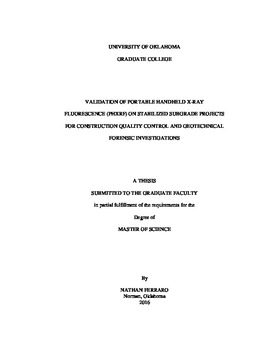| dc.description.abstract | Problematic subgrade soils are often strengthened through pozzolanic reactions and/or cementing using various types of chemical stabilizers, such as lime, cement kiln dust, and fly ash. The amount of stabilizer needed for a particular soil to increase its strength is not codified and typically requires a lengthy mix-design. Once this amount of stabilizer is determined, placed, mixed, and compacted in the field, there is no good way to measure how much stabilizer is actually present throughout the design volume of the subgrade. Furthermore, there is no sophisticated way of assessing stabilization homogeneity throughout the site area and design depth. These shortcomings cause problems not only from a construction quality control standpoint, but from a geotechnical forensic investigation standpoint as well. An existing technology may be able to help with these issues.
X-ray Fluorescence (XRF) has been found to accurately measure the amount of calcium, which is the main element in many chemical stabilizing agents, present in subgrade soils. This study focused on extending the successes found using commercial laboratory XRF spectrometry to portable handheld XRF (PHXRF) spectrometry. Accuracies of two PHXRF devices were verified by comparing their stabilizer content (SC) measurements to measurements made by a proven commercial laboratory.
This research was divided into two major phases: laboratory and field testing. In the laboratory testing portion, engineered samples with known SC were created to evaluate the accuracy of the PHXRF devices and to identify the necessary amount of preparation needed to produce accurate results. Since sample preparation is known to have the greatest influence on the accuracy of the PHXRF spectrometers, a matrix of 70 samples of varying degrees of preparation was created. In the field testing portion, three roadway construction sites that required subgrade stabilization were analyzed using a PHXRF spectrometer. Spatial variability was investigated by taking measurements in a grid pattern, while depth variability was investigated by taking 12 inch deep pre-treatment and post-treatment samples throughout the grid.
The results from the laboratory phase of the experiment are that sample particle size has the most significant effect on PHXRF device accuracy, while scan duration appears to play little to no role. Additionally, effects of sample type and scan technique on PHXRF device accuracy are inconclusive. The results from the field phase of the experiment are that in situ PHXRF SC measurements yield sporadic and inadequate readings, ex situ measurements are capable of producing representative measurements when mathematically corrected, and spatial and depth SC heterogeneity can be detected with PHXRF spectrometry. Ultimately, PHXRF spectrometry shows great promise in construction quality control and forensic geotechnical investigations; however, further development may be necessary before this technology is implemented. | en_US |
